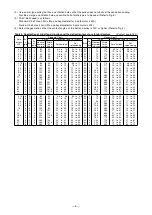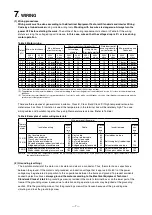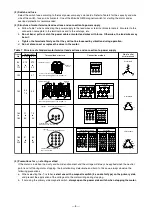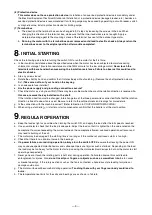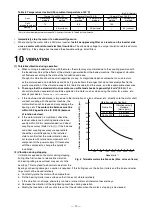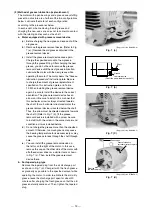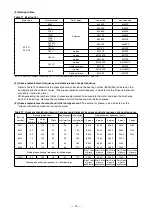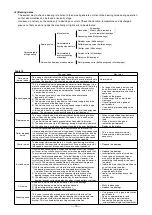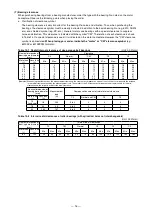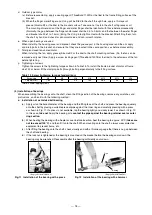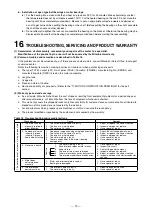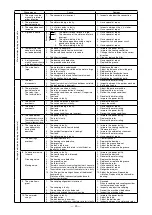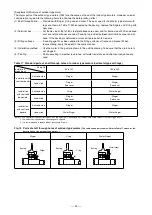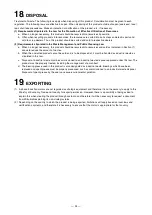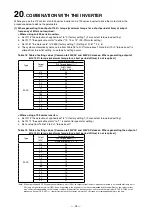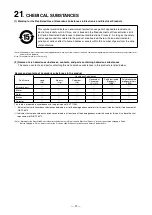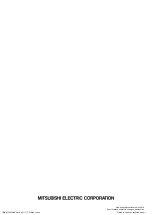
– 20 –
Phenomenon
Cause
Remedy
M
ot
or r
ot
at
es d
ur
in
g n
o
-l
oa
d s
ta
te
1. The motor can be
manually rotated in
either direction.
1. The connection is incorrect.
1. Inspect and adjust the connection.
2. The protection
device functions.
1. The stator winding is faulty.
1. Have specialist repair.
3. The speed does not
increase.
1.
-
Δ
starter contact is faulty.
2. The stator winding is faulty.
1. Inspect and repair the -
Δ
starter.
2. Have specialist repair.
4. A groan is heard.
E
xc
es
si
ve
cu
rr
en
t
1. The motor frictional torque is large.
2. The clearance of the stator and rotor is
incorrect.
3. The stator winding is faulty.
4. One phase opened causing a single
phase state during starting.
5. The stator winding is faulty.
1. Have specialist repair.
2. Have specialist repair.
3. Have specialist repair.
4. Inspect switch and power circuit.
5. Have specialist repair.
5. Temperature rises
abnormally during
no-load operation.
1. The power is abnormal.
2. The cooling ventilation is obstructed.
3. The fan rotation direction is reversed.
4. The filter is clogged.
1. Improve the power facility.
2. Improve the cooling ventilation.
3. Change the fan rotation to the correct
direction.
4. Clean or replace the filter.
6. A rolling sound or
metallic sound is heard
in the bearing section.
1. The bearings are defective.
2. The grease has deteriorated.
1. Have specialist repair.
2. Replace the grease.
7. The vibration is
large.
1. The motor side is unbalanced.
2. Vibration of the parts installed on the motor is large.
3. The rotor is faulty.
4. The foundation is resonating.
5. The strength of the installation frame is weak.
6. The foundation bolts are loose.
1. Rebalance the rotor.
2. Adjust the balance of installed parts.
3. Replace the rotor.
4. Reinforce the foundation frame.
5. Reinforce the installation frame.
6. Retighten the foundation bolts.
D
ur
in
g a l
oa
d (
ro
ta
te
s d
ur
in
g n
o
-l
oa
d s
ta
te
)
1. The belt
disconnects.
1. Overload.
2. The partner machine is faulty and belt does not rotate.
3. The belt tension is incorrect.
1. Reselect the motor rating.
2. Inspect and repair the partner machine.
3. Set the belt again.
2. The protection
device functions.
The relay trips.
The fuse is blown.
1. The partner machine is faulty.
2. The relay or fuse selection is incorrect.
3. The usage conditions are incorrect. Usage time,
frequency.
4. Overload.
5. The power is faulty.
1. Adjust the partner machine.
2. Replace the relay or fuse.
3. Review the usage conditions.
4. Reselect the motor rating.
5. Improve the power facility.
3. The switch
overheats.
1. The switch selection is incorrect.
2. The switch contact is faulty.
1. Reselect the switch.
2. Adjust the switch.
4. The motor
overheats.
1. The stator winding is faulty.
2. Overload.
3. The power is faulty.
4. The usage conditions are incorrect.
1. Have specialist repair.
2. Reselect the motor rating.
3. Improve the power facility.
4. Review the usage conditions.
5. The speed drops.
The speed does not increase.
The acceleration is slow.
The motor does not rotate.
1. The power is faulty.
2. The rotor is faulty.
3. Overload.
1. Improve the power facility.
2. Replace the rotor.
3. Reselect the motor rating.
6. The temperature
rises abnormally
during load
operation.
1. The power is faulty.
2. The cooling ventilation is blocked.
3. The ambient temperature is too high.
4. Overload.
5. The stator winding is faulty.
1. Improve the power facility.
2. Improve the cooling ventilation.
(Remove dirt, etc.)
3. Improve the ambient environment.
4. Reselect the motor rating.
5. Have specialist repair.
7. The bearings
overheat.
1. The shaft center is off.
2. The bearings are defective.
3. Overgreasing.
4. The belt is too tense.
5. The grease has deteriorated, is insufficient, or
the quality is poor.
1. Center the shaft.
2. Replace the bearings.
3. Adjust the grease amount.
4. Adjust the belt tension.
5. Replenish or replace the grease.
8. An abnormal noise
is heard.
Groaning noise.
Moving noise.
1. The power is faulty.
2. The ventilation path is blocked.
3. Overload.
4. The bearings are defective.
5. The grease is poor.
6. The rotor is faulty.
7. The rotor's iron core is contacting the stator's iron core.
8. The rotation section is contacting the stator or outer sheath.
9. The installation of parts such as the bracket or fan is faulty.
10. The fitting at the mating surfaces of the bracket
has worn out.
(Rotation of load is excessively unbalanced.
Excessive vibration)
1. Improve the power facility.
2. Remove the obstacle.
3. Reselect the motor rating.
4. Replace the bearings.
5. Replenish or replace the grease.
6. Replace the rotor.
7. Have specialist repair.
8. Have specialist repair.
9. Retighten or adjust.
10. Adjust the balance. Reduce the
vibration. Replace the bracket and/or
bearing.
9. The vibration is
great.
1. The coupling alignment is incorrect.
2. The coupling is faulty.
3. The machine side is unbalanced.
4. Impact is conveyed from machine side.
1. Recouple.
When recentering and coupling consider
the thermal expansion margin.
2. Inspect and adjust the coupling.
3. Review the machine side balance.
4. Inspect the machine side.
10. The ammeter
sways.
1. The power is faulty.
2. The load varies.
3. The belt tension is incorrect.
4. Cyclic swaying with groan, the stator or rotor is faulty.
1. Improve the power facility.
2. Adjust the load.
3. Adjust the belt tension.
4. Inspect and repair the stator and rotor.

